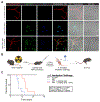Transfusable neutrophil progenitors as cellular therapy for the prevention of invasive fungal infections
- PMID: 35355310
- PMCID: PMC9133213
- DOI: 10.1002/JLB.4HI1221-722R
Transfusable neutrophil progenitors as cellular therapy for the prevention of invasive fungal infections
Abstract
The use of mature neutrophil (granulocyte) transfusions for the treatment of neutropenic patients with invasive fungal infections (IFIs) has been the focus of multiple clinical trials. Despite these efforts, the transfusion of mature neutrophils has resulted in limited clinical benefit, likely owing to problems of insufficient numbers and the very short lifespan of these donor cells. In this report, we employed a system of conditionally immortalized murine neutrophil progenitors that are capable of continuous expansion, allowing for the generation of unlimited numbers of homogenous granulocyte-macrophage progenitors (GMPs). These GMPs were assayed in vivo to demonstrate their effect on survival in 2 models of IFI: candidemia and pulmonary aspergillosis. Mature neutrophils derived from GMPs executed all cardinal functions of neutrophils. Transfused GMPs homed to the bone marrow and spleen, where they completed normal differentiation to mature neutrophils. These neutrophils were capable of homing and extravasation in response to inflammatory stimuli using a sterile peritoneal challenge model. Furthermore, conditionally immortalized GMP transfusions significantly improved survival in models of candidemia and pulmonary aspergillosis. These data confirm the therapeutic benefit of prophylactic GMP transfusions in the setting of neutropenia and encourage development of progenitor cellular therapies for the management of fungal disease in high-risk patients.
Keywords: Aspergillus; Candida; differentiation; fungi; innate immunity; neutropenia.
©2022 Society for Leukocyte Biology.
Figures





Comment in
-
Neutropenia and infections: Neutrophil replacement through genetic engineering.J Leukoc Biol. 2022 Jun;111(6):1131-1132. doi: 10.1002/JLB.1CE0122-031R. Epub 2022 Mar 31. J Leukoc Biol. 2022. PMID: 35362111 No abstract available.

